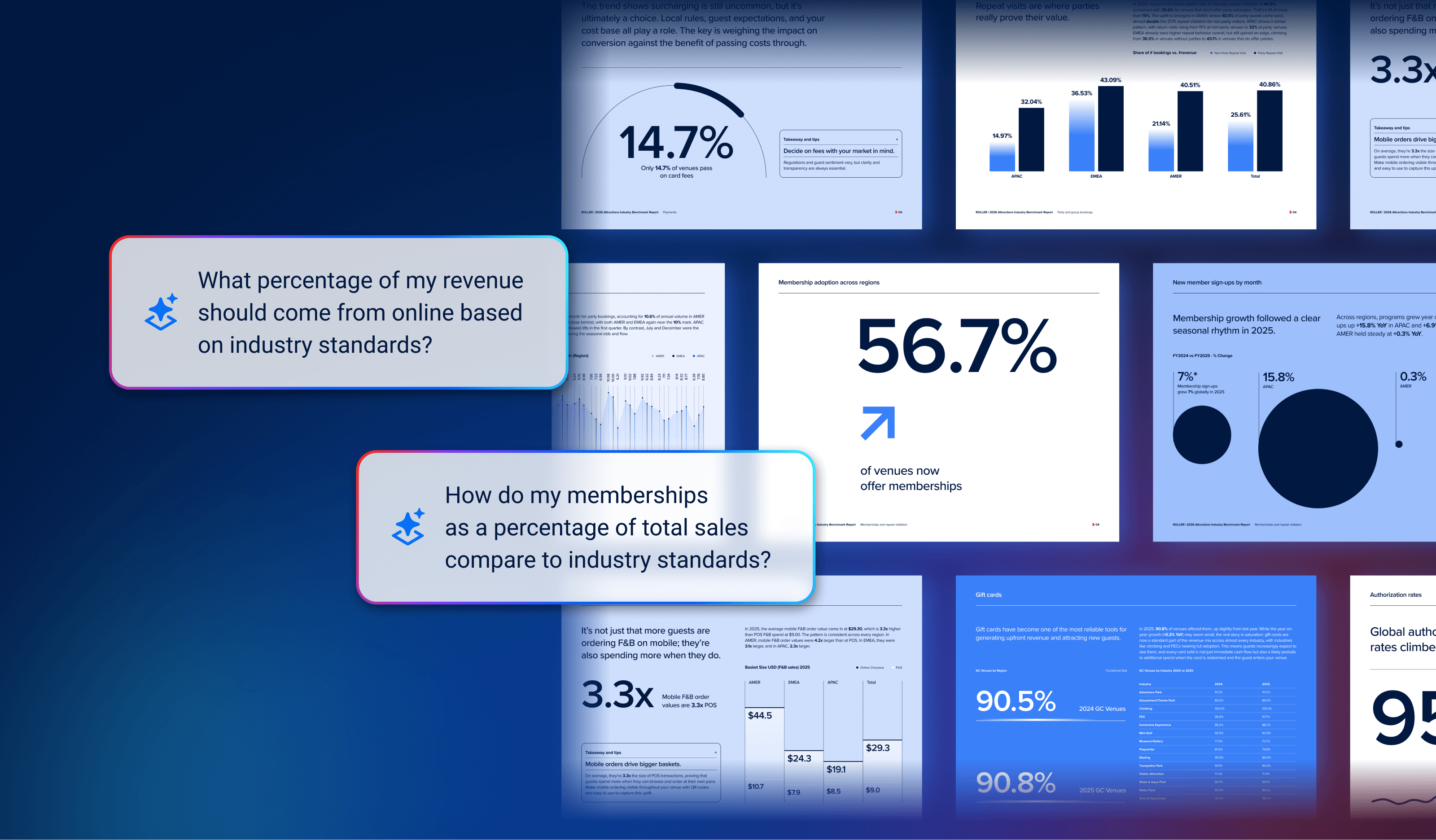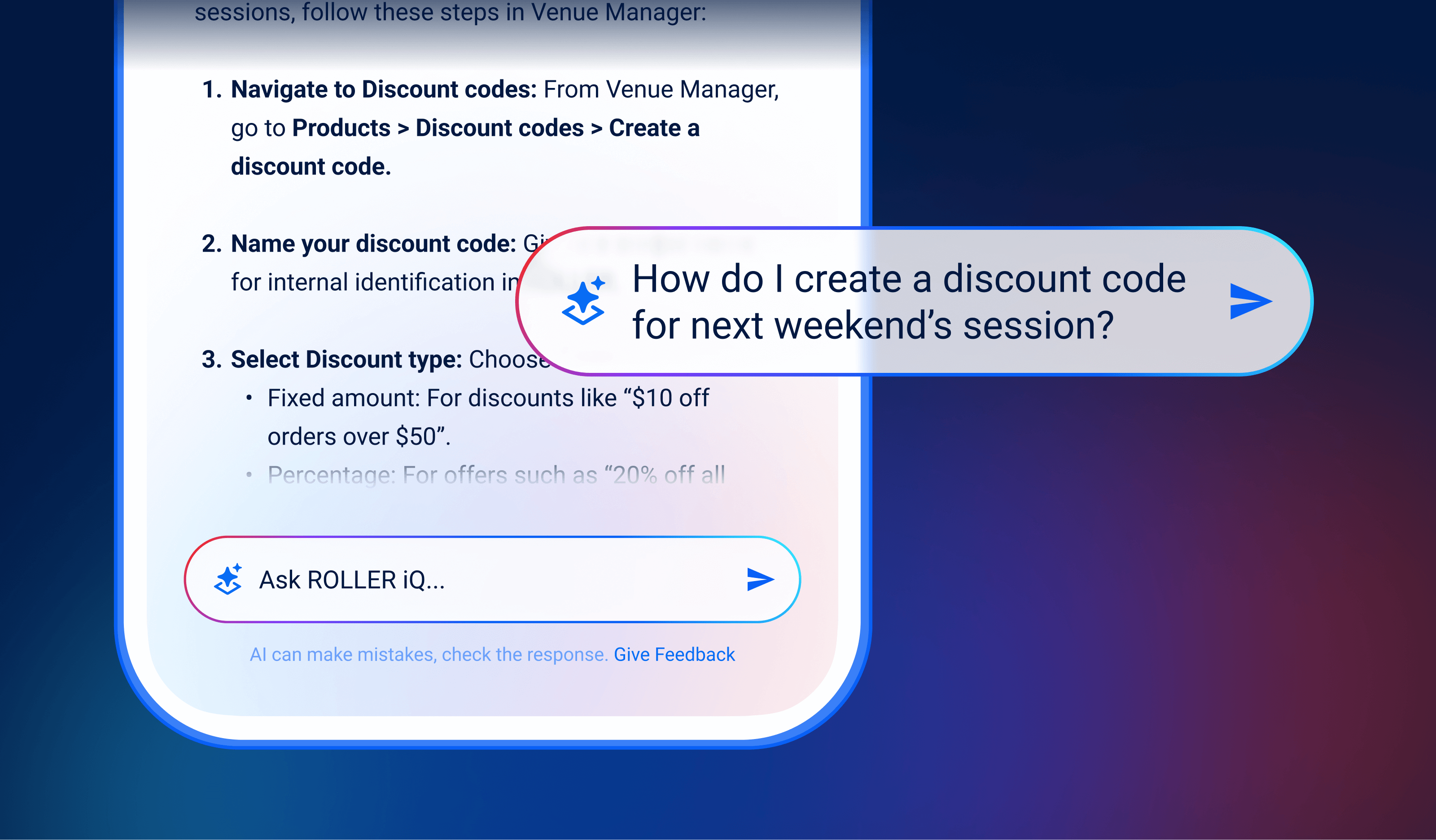Augmented Reality: How to Unlock New Dimensions at Your Venue
.png?width=820&name=Augmented%20Reality_%20How%20to%20Unlock%20New%20Dimensions%20at%20Your%20Venue_Social(2_1).png)
Imagine stepping into a space where magic infuses everyday experiences, all thanks to augmented reality (AR). Envision museums where dinosaurs roam beside you, parks that whisper ancient stories, and galleries where art reaches out to converse. This isn't a glimpse into the future; it's the present, enhanced by AR.
Join us as we explore the endless possibilities of mixing the real with the augmented in attraction venues and making every encounter special.
Key takeaways
- Augmented Reality (AR) transforms passive observation into interactive exploration, making experiences more immersive.
- AR brings a deeper educational layer to exhibits, making learning interactive.
- Unique and evolving AR experiences can attract more visitors and encourage them to return.
- AR seamlessly integrates with physical environments, enriching the visitor experience by adding layers of digital information.
Introduction to augmented reality
Augmented reality (AR) has become a groundbreaking technology, redefining the boundaries of visitor and consumer experiences. Put simply, AR enhances real-world environments by superimposing computer-generated perceptual information, which carefully blends the digital and physical realms. This fusion has opened up new avenues for engaging audiences in ways that were once the stuff of science fiction.
Here are several reasons why attraction venues should consider incorporating AR:
- Enhanced visitor engagement: AR turns passive viewing into active participation. By overlaying interactive elements onto real-world environments, visitors become part of the story, engaging with the content on a deeper level.
- Immersive experiences: AR creates experiences that captivate audiences of all ages. Whether bringing extinct creatures to life in a museum or overlaying historical facts onto landmarks, AR enriches the visitor experience by making your venue more vivid and engaging.
- Educational impact: The interactive nature of AR has the potential to deepen the educational value of attractions. It allows for a more engaging learning experience, where visitors can interact with exhibits in previously unimaginable ways, such as through interactive timelines or 3D models.
- Increased footfall and repeat visits: The novelty and personalized nature of AR experiences can attract more visitors and encourage them to return. Unique AR experiences give venues a competitive edge, appealing to tech-savvy consumers and those looking for new experiences.
- Marketing and branding opportunities: AR offers innovative ways to market attractions and enhance branding. Through AR, venues can create shareable content, engage with visitors before and after their visit, and provide sneak peeks of upcoming exhibits or attractions.
- Accessibility: AR can make attractions more accessible to people with disabilities by providing alternative ways to engage with content that might otherwise be out of reach or difficult to understand.
- Cost-effectiveness: While there is an initial investment in developing AR experiences, they can be cost-effective in the long run. Digital content can be updated without the physical overhaul of exhibits, allowing venues to refresh their offerings with less expense.
Read more: How to Leverage Data for Marketing
Examples of augmented reality experiences in attraction venues
Augmented reality has become a fixture in many attraction venues over the years. Below, you’ll find some successful examples from a variety of different types of venues.
Museums
Smithsonian National Museum of Natural History, Washington D.C: "Skin and Bones" is an AR app that enriches the visitor experience by adding skin and movements to skeletal displays. This innovative tool offers insights into the appearance and behavior of animals, enhancing educational value.
National Museum of Singapore, Singapore: "Story of the Forest" turns watercolor drawings into an immersive AR journey. Visitors interact with flora and fauna, learning about biodiversity in a captivating digital forest.
Kennedy Space Center, Florida: The "Heroes and Legends" exhibit uses AR to animate astronauts with holograms. This immersive experience brings space exploration history to life, connecting visitors with the human stories behind space missions.
Takeaways for museums: AR can significantly enhance the educational and engagement aspects of museum exhibits, allowing visitors to visualize historical events and scientific concepts in a more interactive and immersive manner. Museums can leverage AR to tell richer stories and provide deeper insights into their collections.
Theme parks
Mario Kart: Koopa’s Challenge, Japan: This attraction merges the physical thrill of theme park rides with augmented reality, plunging riders into the competitive world of Mario Kart. Participants experience the iconic game in a dynamic, real-world setting, blending virtual elements with physical kart racing.
Legoland Mythica, United Kingdom: This is an immersive realm where mythical creatures come to life through AR, transforming the park into a fantastical world. Visitors embark on adventures, interacting with creatures and environments that blend physical and digital experiences, enhancing the magic of Legoland.
Takeaways for theme parks: Integrating AR into rides and attractions offers a unique way to blend the digital with the physical, creating memorable, immersive experiences that cannot be easily replicated. Theme parks can use AR to update and refresh traditional attractions, appealing to a wider audience by incorporating popular digital elements.
Zoos and aquariums
General trend: Zoos and aquariums are adopting AR to simulate natural habitats and behaviors of animals, offering an educational layer that complements real-life viewing. These experiences tie into the science curriculum, providing interactive learning opportunities about wildlife and conservation.
Takeaways for zoos and aquariums: AR offers a powerful tool for education and engagement, allowing visitors to better understand animal behaviors and habitats. By simulating environments and interactions, AR can enhance conservation messages and encourage empathy towards wildlife.
Historical sites
Ara Pacis Museum, Rome: The "Ara as it Was" experience uses augmented and virtual reality to transport visitors into ancient Rome, exploring the Ara Pacis altar through immersive 3D reconstructions and a virtual reenactment of historical ceremonies. This innovative approach offers a colorful and multi-sensory journey back to the times of Augustus, making history accessible and engaging through modern technology.
Skriðuklaustur Monastery, Iceland: Through AR, visitors can explore this ancient site's historical and cultural significance. The technology recreates the monastery as it was centuries ago, offering insights into monastic life and the rich history of the region.
Takeaways for historical sites: AR technology can breathe new life into historical sites, making the past accessible and engaging for modern audiences. By visualizing history, AR helps to preserve cultural heritage, educate visitors, and enhance the overall experience of historical exploration.
Art galleries
Pérez Art Museum, Miami: "Invasive Species" by Felice Grodin was an AR-driven exhibition that envisages a future transformed by climate change, prompting reflections on ecological and environmental issues through a blend of digital and physical spaces.
Art Gallery of Ontario, Toronto: "ReBlink" by Alex Mayhew reinterprets traditional artworks. This AR experience encourages viewers to reflect on art, technology, and daily life, offering a fresh perspective on familiar pieces.
Takeaways for art galleries
AR can transform how visitors interact with art, providing new layers of context and interpretation. Galleries can use AR to challenge perceptions, engage with contemporary issues, and create a dialogue between the past and the present. This technology opens up new avenues for creativity and engagement within the art world.
The evolution of augmented reality in attractions
The early days of AR
The journey of augmented reality from a speculative concept in science fiction to a practical tool in attraction venues is a fascinating tale of technological evolution. Initially conceptualized in the early 20th century, AR remained largely theoretical for decades. It wasn't until the late 1990s and early 2000s that the first functional prototypes of AR began to emerge. These early versions, while innovative, were often limited by the technological capabilities of the time, offering a glimpse of the potential but not yet realizing the full vision.
The rise of mobile AR
The last decade, however, has seen exponential growth in AR technology, largely driven by advancements in mobile computing, sensors, and graphics processing. Introducing smartphones and tablets equipped with AR capabilities marked a turning point, making this once-niche technology accessible to the mass market. Attraction venues started experimenting with AR to enhance exhibits and experiences, initially using it as a novel gimmick to attract tech-savvy visitors. This period began a significant shift in how AR was perceived and used in public spaces.
AR today
Today, the role of AR in attraction venues has evolved significantly. No longer just an add-on feature, AR has become a central component of many attractions' visitor experience strategies. Museums use AR to bring historical artifacts to life, theme parks create immersive rides that blend physical and digital elements, and zoos and botanical gardens offer interactive tours where digital elements provide additional information and entertainment. This transformation in the use of AR shows its potential not just to entertain but also to educate and engage visitors in more meaningful ways.
Looking ahead: AR as a driver of future innovations
As technology continues to advance, the role of AR in the attraction venue industry is poised to become even more significant. The shift from novelty to necessity in AR technology underscores a broader trend toward digital integration in the visitor experience. Future developments in AR are expected to continuously redefine the boundaries of what is possible, offering ever-more immersive and interactive experiences that attract, educate, and amaze visitors.
Challenges and considerations
AR can significantly enhance visitor engagement and educational value while potentially increasing revenue. However, it also presents challenges regarding technical investment, accessibility, and balancing innovation with tradition. Here are some of the challenges that need careful consideration.
- Technical and financial aspects: The implementation of AR technology requires substantial technical and financial investment. Developing, maintaining, and regularly updating AR experiences can be resource-intensive.
- Accessibility and inclusivity: Ensuring that AR experiences are accessible and inclusive for all visitors, regardless of their abilities, is crucial. This includes designing user-friendly interfaces and considering various physical and sensory capabilities.
- Balancing traditional and technological attractions: It's important to balance traditional experiences and technological innovations. AR should enhance, not replace, the core elements of the original attractions.
Crafting unforgettable journeys in attractions
The rising significance of AR in attraction venues is no mere trend; it represents a shift in how visitors interact with and experience attractions. From museums and zoos to theme parks and historical sites, AR is being leveraged to create immersive, interactive experiences that captivate visitors of all ages. The technology's unique ability to overlay information, visuals, and interactive elements onto real-world settings has transformed the traditional visitor experience into something dynamic and engaging.
The potential of AR in the attraction venue industry is vast. It can transform passive observation into active participation, turning a visit into an adventure. Visitors are no longer just viewers; they participate in a narrative that unfolds around them. This enhanced engagement not only heightens the enjoyment but also deepens the educational impact of attractions. The novelty and personalized nature of AR experiences can increase visitor footfall and encourage repeat visits, providing a competitive edge in an increasingly digital-centric world.
Find out how ROLLER can help your venue offer modern experiences.
Related articles


Smarter Support With ROLLER iQ: Step-by-Step Help, Right When You Need It
.png)
What is an AI Business Assistant? (And How It Supports Growth for Attractions)
Enhance your guest experience
Get free education, tips and inspiration to help you run a successful venue.